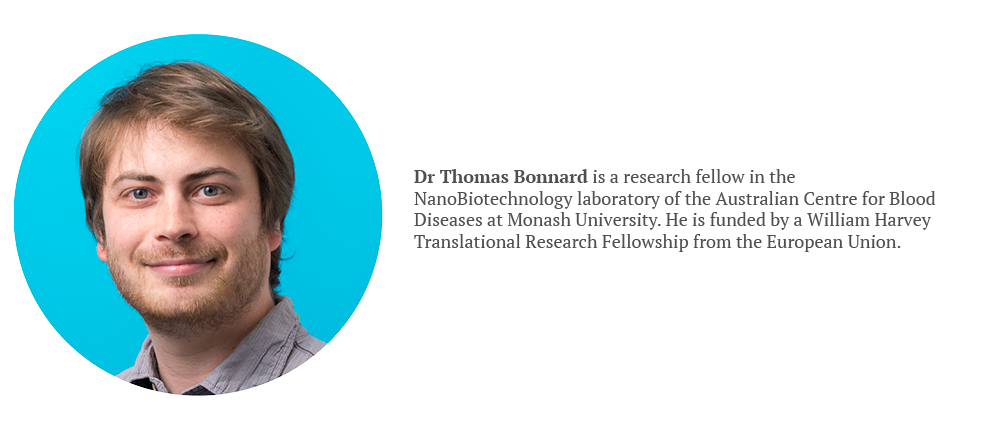
Can you describe the aim of your research in 10 words?
To improve heart disease treatment with nanomedical devices.
What have you discovered/achieved in this area so far?
During my PhD back in France at the Laboratory for Vascular Translational Science, I developed sugar-based nanoparticles, which can be used as tools in molecular imaging of vascular inflammation to improve the diagnosis of abdominal aortic aneurysm with SPECT/CT or MRI imaging modalities. More recently at the Baker IDI and the Australian Centre for Blood Diseases, I worked on this novel and promising thrombolytic molecule.
What aspect of this research excites you the most?
I think the idea of bypassing the clotting system to initiate fibrinolysis is a particularly smart approach. Exploiting key enzymes upregulated by the pathological condition to activate the treatment of this same pathology is to me the finest strategy to fight a disease.
It enables self-adjustment of the therapeutic activity according to the degree of advancement of the disease while acting only at the specific area of the disease – thereby suppressing unwanted systemic side effects. The NanoBiotechnology laboratory gathers all the necessary expertise in protein engineering and nanoparticle synthesis to make possible the development of such smart drug delivery systems and this is very exciting.
What’s your Holy Grail – the one thing you’d like to achieve in your research career?
What would please me the most is that our research effort actually benefits people by improving the treatment of heart diseases. This is I think the Holy Grail of most medical researchers.
What is your biggest research hurdle?
You have to appreciate problem solving to enjoy research. We often face some puzzling results and may have a hard time troubleshooting and understanding the experiments’ outcomes.
It can be discouraging and you may spend many hours reading all the scientific publications dealing with the issue and repeating the experiments in all the different conditions you can think of. But on the other hand, when you do solve the problem, there is great satisfaction!
How long before your work impacts patient care?
This novel thrombolytic drug we developed has shown promising effects in preclinical studies, but this is only the first step. There is a long way to go. These results need to be confirmed in different models of thrombosis, closer to the human pathology, while some toxicity testing will also be performed to confirm that the drug could be administered to people without causing any unexpected side effects.
In the meantime, we would need to find investors to finance the first phase clinical trial. If everything goes well, clinical trials could start in 2 to 3 years. If successive trial phases are positive and reveal a beneficial effect, the drug could be approved for use in clinic in 5 to 6 years.
Who has inspired you and why?
I have encountered many great people across my different research experiences and I’d like to think I have been inspired by all of them. In an institute like the ACBD where the environment is set to encourage collaboration with other researchers, you find yourself discussing science with many specialists in their own topic areas and you learn a lot from them. The other major source of inspiration is the work from other research groups in the field, which I follow closely.
Describe your perfect day.
A day where you finally make this important experiment work after a month of troubleshooting!!!
If you could only keep three possessions, what would they be?
My Wii U, the new Zelda and a TV !!